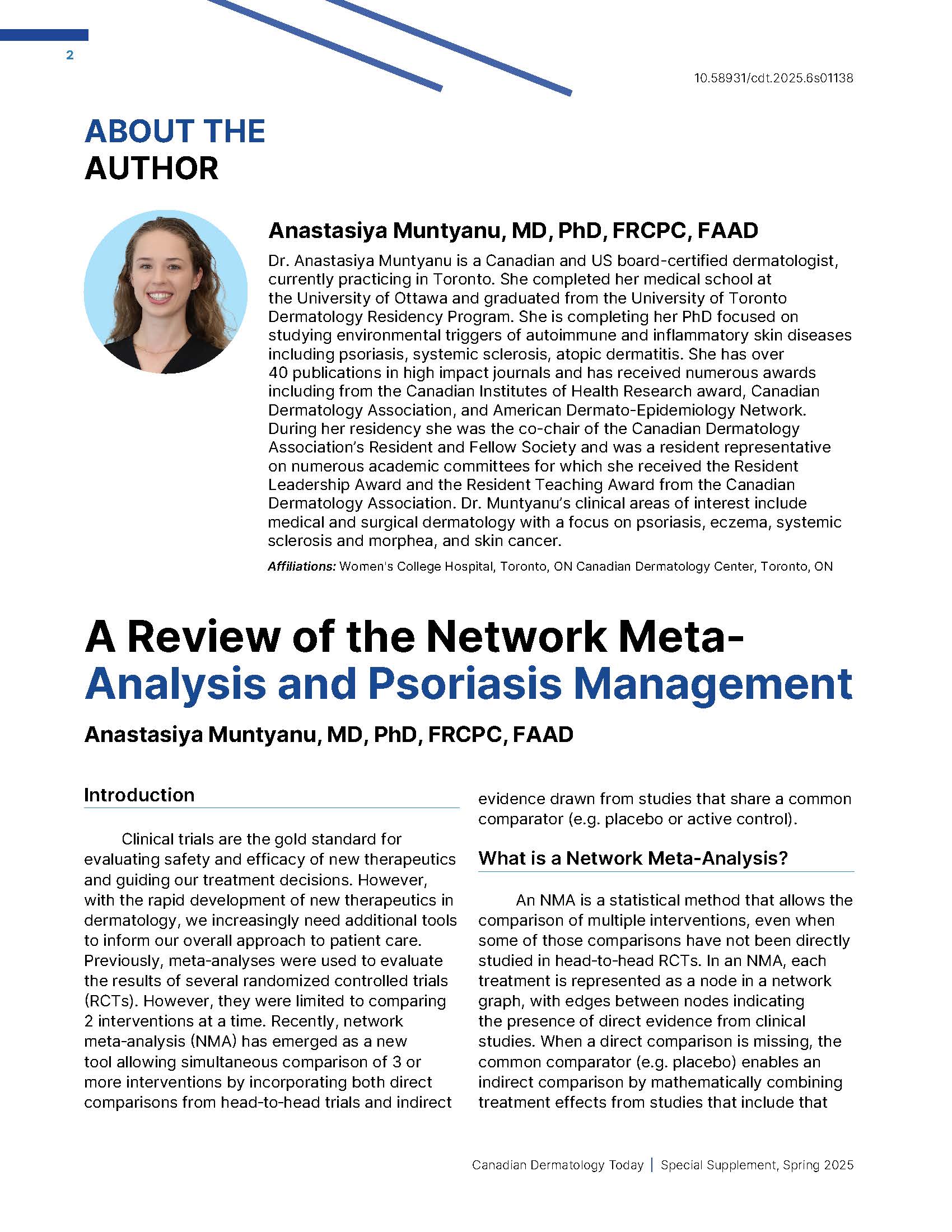A Review of the Network Meta-Analysis and Psoriasis Management
DOI:
https://doi.org/10.58931/cdt.2025.6s01138Abstract
Clinical trials are the gold standard for evaluating safety and efficacy of new therapeutics and guiding our treatment decisions. However, with the rapid development of new therapeutics in dermatology, we increasingly need additional tools to inform our overall approach to patient care. Previously, meta‐analyses were used to evaluate the results of several randomized controlled trials (RCTs). However, they were limited to comparing 2 interventions at a time. Recently, network meta‐analysis (NMA) has emerged as a new tool allowing simultaneous comparison of 3 or more interventions by incorporating both direct comparisons from head‐to‐head trials and indirect evidence drawn from studies that share a common comparator (e.g. placebo or active control).
References
Brignardello-Petersen R, Guyatt GH. Introduction to network meta-analysis: understanding what it is, how it is done, and how it can be used for decision-making. Am J Epidemiol. 2024. doi:10.1093/aje/kwae260
Rouse B, Chaimani A, Li T. Network meta-analysis: an introduction for clinicians. Intern Emerg Med. 2017;12(1):103-111. doi:10.1007/s11739-016-1583-7
Jansen JP, Naci H. Is network meta-analysis as valid as standard pairwise meta-analysis? It all depends on the distribution of effect modifiers. BMC Med. 2013;11(1):159. doi:10.1186/1741-7015-11-159
Florez ID, De La Cruz-Mena JE, Veroniki AA. Network meta-analysis: a powerful tool for clinicians, decision-makers, and methodologists. J Clin Epidemiol. 2024;176:111537. doi:10.1016/j.jclinepi.2024.111537
Singh J, Gsteiger S, Wheaton L, Riley RD, Abrams KR, Gillies CL, et al. Bayesian network meta-analysis methods for combining individual participant data and aggregate data from single arm trials and randomised controlled trials. BMC Med Res Methodol. 2022;22(1):186. doi:10.1186/s12874-022-01657-y
Salanti G, Nikolakopoulou A, Efthimiou O, Mavridis D, Egger M, White IR. Introducing the treatment hierarchy question in network meta-analysis. Am J Epidemiol. 2022;191(5):930-938. doi:10.1093/aje/kwab278
Phillips MR, Steel DH, Wykoff CC, Busse JW, Bannuru RR, Thabane L, et al. A clinician's guide to network meta-analysis. Eye (Lond). 2022;36(8):1523-1526. doi:10.1038/s41433-022-01943-5
Lunny C, Veroniki A-a, Higgins JPT, Dias S, Hutton B, Wright JM, et al. Methodological review of NMA bias concepts provides groundwork for the development of a list of concepts for potential inclusion in a new risk of bias tool for network meta-analysis (RoB NMA Tool). Syst Rev. 2024;13(1):25. doi:10.1186/s13643-023-02388-x
Guelimi R, Afach S, Régnaux JP, Bettuzzi T, Chaby G, Sbidian E, et al. Overlapping network meta-analyses on psoriasis systemic treatments, an overview: quantity does not make quality. Br J Dermatol. 2022;187(1):29-41. doi:10.1111/bjd.20908
Augustin M, Valencia Lopez M, Reich K. Network meta-analyses in psoriasis: overview and critical discussion. J Eur Acad Dermatol Venereol. 2021;35(12):2367-2376. doi:10.1111/jdv.17650
Sbidian E, Chaimani A, Guelimi R, Garcia-Doval I, Hua C, Hughes C, et al. Systemic pharmacological treatments for chronic plaque psoriasis: a network meta-analysis. Cochrane Database Syst Rev. 2023;7(7):CD011535. doi:10.1002/14651858.CD011535.pub6
Armstrong A, Fahrbach K, Leonardi C, Augustin M, Neupane B, Kazmierska P, et al. Efficacy of bimekizumab and other biologics in moderate to severe plaque psoriasis: a systematic literature review and a network meta-analysis. Dermatol Ther (Heidelb). 2022;12(8):1777-1792. doi:10.1007/s13555-022-00760-8
Armstrong AW, Soliman AM, Betts KA, Wang Y, Gao Y, Stakias V, et al. Long-term benefit–risk profiles of treatments for moderate-to-severe plaque psoriasis: a network meta-analysis. Derm Ther (Heidelb). 2022;12(1):167-184. doi:10.1007/s13555-021-00647-0


